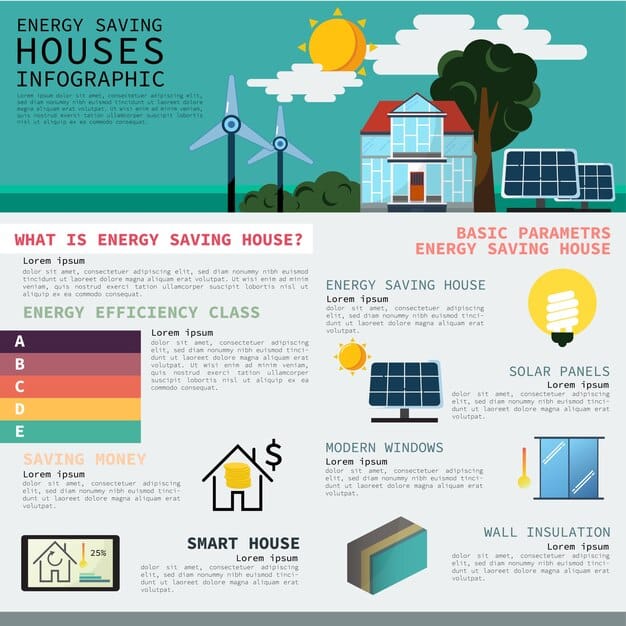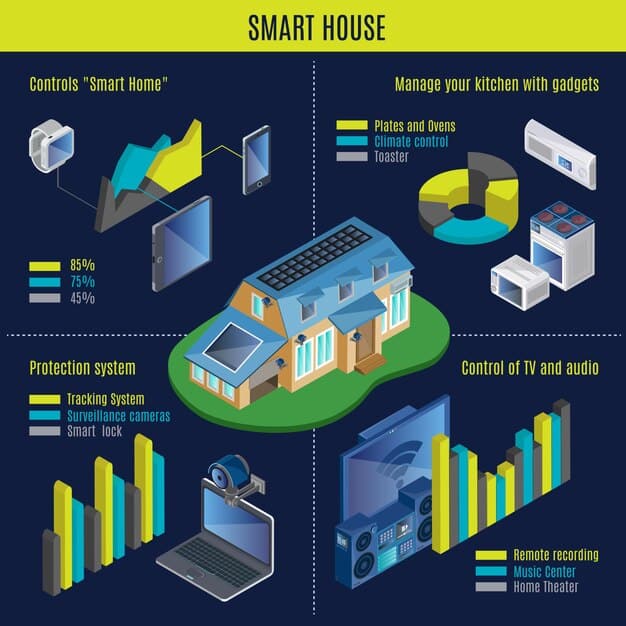US Government Solar Incentives 2025: What You Need to Know

The US government continues to offer a robust suite of incentives for solar panel installation in 2025, primarily through federal income tax credits and various state and local programs, aiming to accelerate the nation’s transition to renewable energy.
As the urgency for sustainable energy solutions intensifies, many homeowners and businesses are shifting their gaze towards solar power. Understanding What are the Latest US Government Incentives for Solar Panel Installation in 2025? is crucial for anyone considering this significant investment. These incentives can dramatically reduce upfront costs and accelerate the return on investment, making solar more accessible and appealing than ever.
The Federal Solar Investment Tax Credit (ITC) in 2025
The cornerstone of federal support for solar energy remains the Investment Tax Credit (ITC), often referred to as the federal solar tax credit. This incentive allows homeowners to deduct a significant percentage of the cost of installing a solar energy system from their federal taxes. For 2025, the ITC is set at a robust 30% for residential and commercial solar installations, a continuation of the rate solidified by the Inflation Reduction Act of 2022. This credit is not a deduction from income but a direct dollar-for-dollar reduction in what you owe in federal taxes, making it exceptionally valuable.
This non-refundable credit can be carried forward if the tax liability is less than the credit amount in a given year. The ITC covers the cost of solar panels, inverters, mounting equipment, and even labor costs for installation. It also includes the cost of energy storage devices like solar batteries, provided they are charged at least 75% by the solar system. This comprehensive coverage helps to make the overall investment in solar power more financially viable for a wider range of Americans, pushing the nation towards its clean energy goals.
Understanding the ITC’s Continued Impact
The consistent 30% ITC through 2032 provides long-term certainty for consumers and the solar industry. This stability is critical for planning and investment, encouraging more individuals and businesses to make the switch to solar without the uncertainty of expiring incentives. The clear roadmap for the ITC underscores the government’s commitment to renewable energy as a key component of its climate strategy.
Understanding the specific eligibility requirements is essential. The system must be new or being used for the first time, not leased, and located at a residence within the United States. While the ITC is primarily a federal incentive, its substantial impact often forms the foundation upon which other state and local incentives are built, creating a layered approach to solar affordability. This stacking of incentives further enhances the financial attractiveness of solar adoption across various regions.
- 30% Tax Credit: Applies to the gross cost of solar installation.
- Long-Term Stability: Guaranteed through 2032, then phases down.
- Broad Coverage: Includes equipment, labor, and battery storage.
- Direct Tax Reduction: Not a deduction from taxable income.
The ITC stands as a powerful testament to the federal government’s enduring commitment to fostering widespread solar energy adoption, providing a substantial financial boost for those looking to invest in sustainable power.
State-Level Solar Incentives and Programs
While the federal ITC provides a baseline of support, many states offer complementary incentives that significantly enhance the financial benefits of solar installation. These state-specific programs vary widely, encompassing everything from additional tax credits and rebates to performance-based incentives and favorable net metering policies. Understanding the landscape of state-level support is vital for anyone planning a solar project in 2025, as these can dramatically alter the overall cost and savings.
States like California, Massachusetts, and New York have historically been leaders in solar adoption, partly due to their aggressive incentive programs. These often include state tax credits that function similarly to the federal ITC, further reducing the final net cost. Rebates, offered by state energy offices or local utility companies, provide an upfront reduction in the purchase price, making solar more immediately affordable. These rebates can sometimes be combined with tax credits, maximizing instant savings.
Renewable Energy Certificates (RECs) and SRECs
Beyond direct financial incentives, many states operate markets for Renewable Energy Certificates (RECs) or Solar Renewable Energy Certificates (SRECs). These are market-based instruments that certify that one megawatt-hour of electricity was generated from a renewable energy source. When you generate solar power, you may earn SRECs, which can then be sold to utility companies or other entities that need to meet renewable energy mandates. This creates an ongoing revenue stream for solar system owners, effectively paying them for the clean energy they produce.

The value of SRECs fluctuates based on supply and demand within the state’s market, but they can contribute substantially to the financial viability of a solar investment. States with robust SREC markets include New Jersey, Maryland, and Pennsylvania. The mechanisms for selling SRECs vary, with some homeowners opting to work with SREC aggregators who handle the sales on their behalf.
In addition to performance-based incentives, many states offer property tax exemptions for the added value that a solar system brings to a home. This prevents an increase in property taxes due to a clean energy upgrade, further sweetening the deal. Some states also provide sales tax exemptions on solar equipment, reducing the initial purchase price.
- State Tax Credits: Further reduce the net cost after federal credit.
- Cash Rebates: Upfront reductions on installation expenses.
- SREC Markets: Generate income by selling renewable energy credits.
- Property/Sales Tax Exemptions: Avoid increased taxes on system value.
The synergy between federal and state incentives is a powerful driver for solar adoption, creating a more attractive financial landscape for homeowners and businesses across various regions. Potential solar owners should research their specific state’s offerings to fully capitalize on available benefits.
Local Incentives and Utility Programs
While federal and state incentives form the backbone of solar support, a significant layer of financial benefit often comes from local municipalities and utility companies. These localized incentives can vary widely from city to city and even from one utility service area to another, emphasizing the importance of thorough, localized research when planning a solar installation for 2025. These granular programs are designed to address specific local energy needs and encourage adoption within their service territories.
Many local governments offer property assessed clean energy (PACE) programs, which allow property owners to finance energy efficiency and renewable energy improvements through a voluntary assessment on their property tax bill. This mechanism helps overcome upfront cost barriers by spreading the cost over a longer period, often 10-20 years. PACE programs are authorized by state legislation and administered by local governments, making solar accessible without requiring a large initial cash outlay or traditional loan. However, it’s crucial to understand the implications of PACE loans on property transfers.
Utility Net Metering Policies
One of the most impactful local incentives for residential solar is net metering. This policy allows solar system owners to send excess electricity generated by their panels back to the grid. In return, they receive credits on their electricity bill, effectively rolling back their meter. When the solar panels aren’t generating enough power (e.g., at night), the home draws electricity from the grid, and the stored credits are used to offset the cost.
Net metering policies vary significantly by utility and state. Some utilities offer full retail rate net metering, meaning you get the same price for your excess electricity as you pay for electricity from the grid. Others offer a reduced rate or transition to newer policies like “net billing” or “buy-back” rates, where compensation for exported power is lower than the retail rate. Understanding the specific net metering policy in your utility’s service area is critical for projecting long-term savings and system payback periods. This policy directly influences the financial returns of your solar investment.
Additional local programs might include:
- Municipal Rebates: Direct cash back from city or county governments.
- Community Solar Programs: Allow residents to subscribe to a local solar farm and receive credits on their electricity bill, often without installing panels on their own property.
- Low-Interest Loans: Partnerships with local financial institutions to offer favorable loan terms for solar installations.
- Permitting Fee Waivers: Some local governments waive or reduce fees associated with solar installation permits.
These various local and utility-specific incentives underscore the dynamic nature of solar financial landscapes across the US. Homeowners are encouraged to consult with local solar installers and utility providers to uncover all available programs in their specific area for 2025.
Expanded Access Grants and Programs
Beyond direct financial incentives, the US government is increasingly focusing on expanding access to solar energy for underserved communities, low-income households, and non-profit organizations. Initiatives under consideration for 2025 are likely to build upon existing programs, offering grants, technical assistance, and specialized financing options that reduce barriers to entry for these groups. The goal is to ensure that the benefits of clean energy are equitably distributed across all demographics.
One notable area of expansion involves grant opportunities. The Department of Energy (DOE) and other federal agencies frequently announce competitive grants for community solar projects, solar development in tribal lands, and solar initiatives for affordable housing. These grants typically cover a significant portion of project costs, making solar viable for entities that might not otherwise have the capital for such investments. Non-profits, housing authorities, and community organizations are often key beneficiaries of these programs, enabling them to bring clean energy to those who need it most.
The Inflation Reduction Act’s Equity-Focused Additions
The Inflation Reduction Act (IRA) of 2022 introduced several provisions aimed at democratizing access to solar. While the 30% ITC is broadly available, the IRA includes “adders” to the base credit for projects that meet specific criteria. For instance, projects located in “energy communities” (areas with significant fossil fuel employment or related infrastructure) or low-income communities can qualify for additional percentage points on their ITC. This means a project in a qualified area could potentially access an ITC greater than 30%, further enhancing its financial appeal.
Furthermore, direct pay elections for certain tax credits, including those for clean energy, are now available for tax-exempt organizations and governmental entities. This allows groups like rural electric cooperatives and municipal utilities to receive a direct cash payment for the value of the tax credit, rather than needing taxable income to utilize the credit. This is a game-changer for many non-profit and public entities, making renewable energy projects more financially accessible and less dependent on complex tax equity structures.
Additional programs under investigation for 2025 expansion include:
- Community Solar Development: Support for shared solar farms that benefit multiple households.
- Technical Assistance: Providing expertise and resources for project planning and implementation in underserved areas.
- Job Training & Workforce Development: Programs to prepare individuals from disadvantaged communities for careers in the solar industry.
- Targeted Loan Programs: Low-interest loans or loan guarantees specifically for solar projects in low-income areas or for historically marginalized groups.
These expanded access grants and programs reflect a growing commitment to energy equity, ensuring that the transition to a clean energy economy leaves no community behind. Staying informed about calls for applications and eligibility criteria for these initiatives is crucial for organizations looking to leverage solar for broader social and environmental impact.
Navigating the Solar Installation Process and Maximizing Incentives
Embarking on a solar panel installation journey involves several key steps, from initial assessment to final commissioning. Understanding this process, and how to strategically align it with available incentives, is crucial for maximizing your financial benefits in 2025. A well-planned approach can significantly streamline the installation and ensure you receive every incentive for which you qualify.
The first step typically involves a professional site assessment. A reputable solar installer will evaluate your roof’s suitability, including its angle, sun exposure, and structural integrity. They will also analyze your historical electricity consumption to design a system that optimally meets your energy needs. During this phase, it’s vital to discuss all potential federal, state, and local incentives. A knowledgeable installer should be able to provide a comprehensive breakdown of how these incentives will apply to your specific project, including estimated savings and return on investment.
Key Considerations and Documentation
Documentation is paramount for claiming incentives. For the federal ITC, you’ll need to keep careful records of all project costs, including equipment purchases and installation labor. Your solar installer will typically provide an itemized invoice. When filing your federal taxes, you’ll use IRS Form 5695, Residential Clean Energy Credit, to claim the ITC. It’s advisable to consult with a tax professional to ensure accurate reporting and maximize your credit. Many solar companies have partnerships with tax experts who specialize in clean energy credits.
For state and local incentives, the requirements vary. Some rebates require pre-approval before installation, while others are applied for post-completion. Utility net metering applications need to be submitted and approved before your system can be interconnected to the grid. Your solar installer will typically handle most of the permitting and interconnection paperwork, but it’s important to understand the process and your responsibilities.

Consider the timing of your installation. To claim the federal ITC for a given tax year, your solar system must be “placed in service” within that year. This means the system is fully installed, operational, and connected to the grid. Delays in permitting or supply chains could push your project into the next tax year, so plan accordingly, especially towards year-end.
Beyond incentives, consider financing options. Many homeowners opt for solar loans or power purchase agreements (PPAs) that allow them to go solar with little or no upfront cost. While these arrangements impact how incentives are realized (e.g., the owner of the system claims the ITC, which may be the financier in a PPA), they make solar accessible to a broader audience.
- Due Diligence: Research reputable, experienced solar installers.
- Incentive Integration: Ensure installers factor ALL applicable incentives into their quotes.
- Documentation: Maintain meticulous records for tax credits and rebates.
- Professional Advice: Consult with tax and financial advisors.
Navigating the solar installation process in 2025, with an eye on maximizing the latest US government incentives, can be a complex but highly rewarding endeavor. A proactive and informed approach will ensure you harness the full financial benefits of your transition to clean energy.
Future Outlook and Emerging Trends in Solar Incentives
Looking beyond 2025, the trajectory for US government incentives for solar panel installation appears stable, with a strong emphasis on maintaining momentum while adapting to emerging challenges and opportunities. The current policies suggest a long-term commitment to solar, but future trends indicate a likely shift towards more performance-based incentives and greater integration with grid modernization efforts. Understanding these potential shifts is key for future-proofing solar investments.
The federal Investment Tax Credit (ITC) is legislated to remain at 30% through 2032, providing significant stability for the next several years. After 2032, it reduces to 26% in 2033 and 22% in 2034, then expires for residential solar in 2035 (though a permanent 10% credit remains for commercial solar). This phasedown signals a transition towards a more mature market, where solar may become financially viable with less direct subsidy, driven by continued cost reductions and technological advancements.
Focus on Energy Storage and Grid Resilience
A growing trend in solar incentives is the emphasis on energy storage solutions, such as batteries. The federal ITC already covers standalone battery storage, provided it’s charged at least 75% by a solar array. Many states and utilities are also introducing specific incentives for battery installations, recognizing their critical role in grid stability and resilience. As more solar comes online, batteries help to smooth out power supply fluctuations and can provide backup power during outages, enhancing the value proposition of a solar-plus-storage system.
Future incentives may increasingly focus on smart grid integration and demand-side management. Programs that encourage homeowners to optimize their energy usage in response to grid conditions, or that allow utilities to dispatch stored solar power from residential batteries, are likely to gain prominence. This shift moves beyond simply generating clean energy to making energy systems more efficient, reliable, and responsive.
Potential new areas for incentive development include:
- Virtual Power Plants (VPPs): Incentives for homeowners to aggregate their distributed solar and storage systems into a collective resource that can provide grid services.
- Electrification Incentives: Broader incentives that combine solar with other home electrification measures, such as heat pumps and EV chargers, to create fully decarbonized homes.
- Domestic Manufacturing Bonus: Additional tax credits or grants for solar components sourced from US manufacturers, further strengthening domestic supply chains.
- Resilience Incentives: Funding for solar-plus-storage systems specifically designed to enhance community resilience against natural disasters or grid disruptions.
The future of solar incentives in the US is likely to be dynamic, evolving to meet new energy demands, support technological innovation, and ensure equitable access. Staying informed about legislative changes at both federal and state levels will be essential for anyone looking to invest in solar or participate in the clean energy transition in the coming years.
The Economic and Environmental Benefits of Solar Adoption
The decision to install solar panels in 2025, heavily influenced by robust US government incentives, extends far beyond mere financial savings. This shift towards renewable energy carries profound economic and environmental benefits, contributing to national energy independence, job creation, and a significant reduction in carbon emissions. Understanding these broader impacts adds another layer of appreciation for the ongoing governmental support for solar.
Economically, solar adoption directly translates to lower electricity bills for homeowners and businesses, providing a hedge against rising energy costs and enhancing long-term financial stability. This reduction in operational expenses can be particularly beneficial for businesses, allowing them to reinvest savings or improve their competitive edge. At a macro level, the growth of the solar industry fuels job creation across various sectors, from manufacturing and installation to research and development and sales. These are often well-paying, local jobs that contribute to regional economic vitality.
Environmental Impact and Climate Mitigation
From an environmental perspective, the benefits of solar energy are immense. By harnessing the sun’s power, solar panels generate electricity without producing greenhouse gas emissions, significantly reducing the carbon footprint associated with conventional fossil fuel-based power generation. This plays a critical role in mitigating climate change, improving air quality, and preserving natural ecosystems. Every kilowatt-hour generated by solar means fewer emissions released into the atmosphere, contributing directly to a cleaner, healthier planet.
Furthermore, increased solar adoption reduces reliance on finite fossil fuel resources and lessens susceptibility to global energy market volatility. This enhances national energy security and promotes greater self-sufficiency. The distributed nature of solar power, where electricity is generated closer to where it’s consumed, also reduces transmission losses and can alleviate stress on aging grid infrastructure, contributing to a more resilient and efficient energy system.
The benefits are clearly multifaceted:
- Reduced Energy Bills: Long-term savings for consumers and businesses.
- Economic Growth: Creation of domestic jobs in a growing clean energy sector.
- Carbon Emission Reduction: Direct combat against climate change and improved air quality.
- Energy Independence: Less reliance on volatile fossil fuel markets and foreign energy sources.
- Grid Resilience: Decentralized power generation enhances reliability.
The synergy between robust government incentives, such as those available in 2025, and these compelling economic and environmental advantages makes solar panel installation a powerful investment. It’s an investment not just in personal savings, but in a sustainable future for communities and the nation as a whole.
| Key Point | Brief Description |
|---|---|
| ☀️ Federal 30% ITC | A 30% federal tax credit on solar installation costs, valid through 2032, significantly reducing upfront expenses. |
| 🏡 State & Local Programs | Varying state tax credits, rebates, SREC markets, and favorable net metering policies enhance local affordability. |
| 🤝 Expanded Access | Grants and targeted incentives aim to bring solar to low-income and underserved communities. |
| 💰 Economic & Green Benefits | Lower bills, job creation, reduced carbon emissions, and enhanced energy independence. |
Frequently Asked Questions About Solar Incentives
The primary federal incentive is the Investment Tax Credit (ITC), which offers a 30% tax credit on the total cost of solar panel installation for systems placed in service in 2025. This credit applies to both residential and commercial projects and helps significantly reduce the out-of-pocket expenses by directly cutting your federal tax liability.
The 30% federal solar tax credit is legislated to remain in effect through the end of 2032. After that, it phases down to 26% in 2033 and 22% in 2034. For residential projects, the credit is set to expire in 2035, providing a clear window for homeowners to take advantage of this substantial incentive.
Yes, in most cases, you can combine federal incentives like the ITC with state and local programs. Many state tax credits, rebates, and net metering policies are designed to complement the federal credit, creating a layered approach to affordability. It’s crucial to research specific programs in your area, as stacking rules can vary.
Net metering is a billing policy that allows solar system owners to send excess electricity generated by their panels back to the grid. In return, they receive credits from their utility company, which are applied to their electricity bill. This effectively reduces or even eliminates monthly electricity costs, maximizing savings for solar owners.
Yes, solar batteries and other energy storage devices are eligible for the 30% federal Investment Tax Credit in 2025, provided they are charged at least 75% by a solar energy system. This inclusion recognizes the growing importance of energy storage for grid stability and increased energy independence for homeowners. State and local incentives for batteries also exist.
Conclusion
The landscape of US government incentives for solar panel installation in 2025 is remarkably robust, anchored by the long-standing 30% federal Investment Tax Credit. This, coupled with a diverse array of state and local programs, including tax credits, rebates, SREC markets, and favorable net metering policies, creates a compelling financial case for transitioning to solar energy. These incentives not only make solar power more accessible and affordable for a broader range of households and businesses but also underpin the nation’s strategic push towards a sustainable and energy-independent future. As the move towards clean energy becomes increasingly critical, staying informed about these evolving support mechanisms is essential for maximizing both personal financial gains and collective environmental impact.





